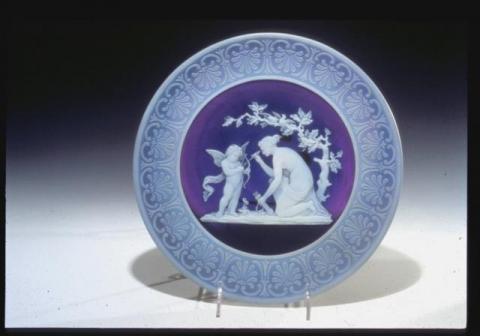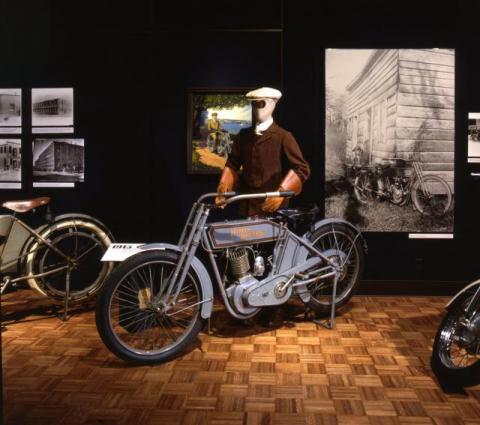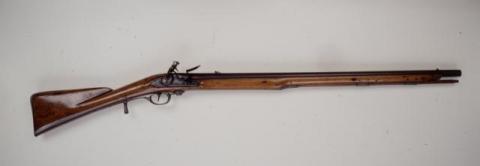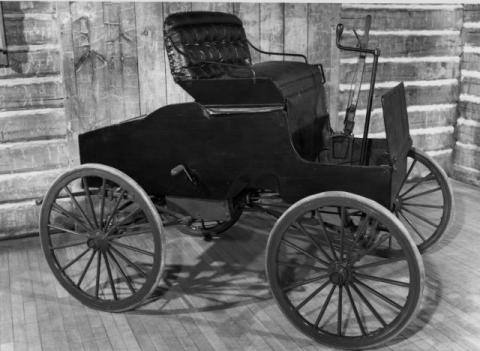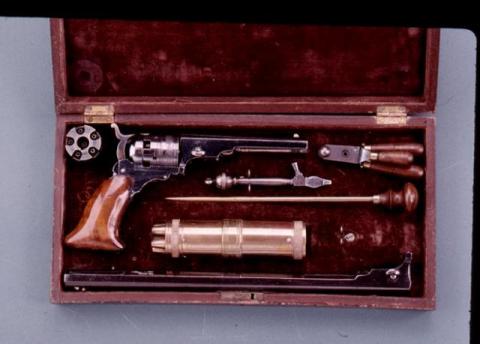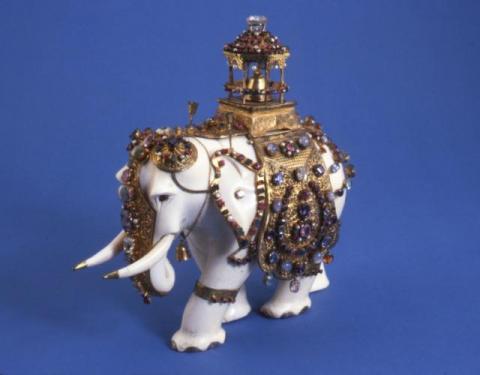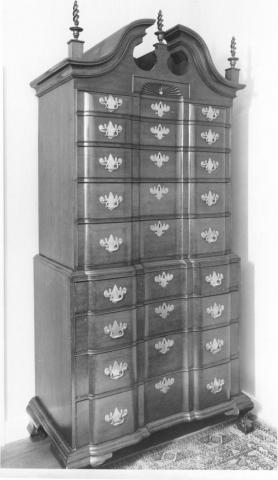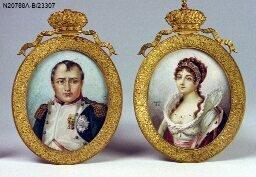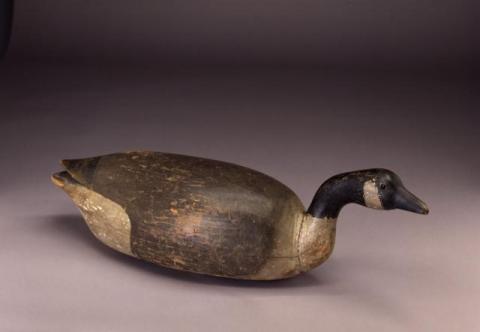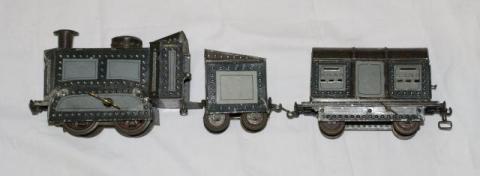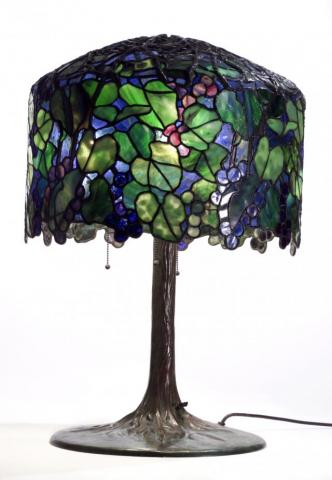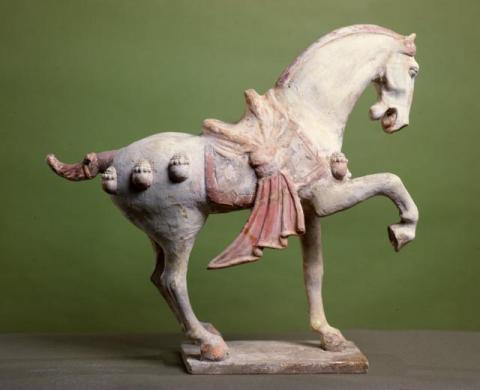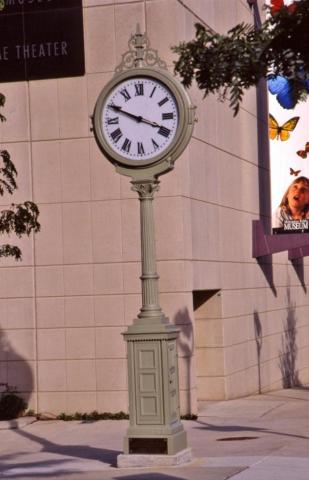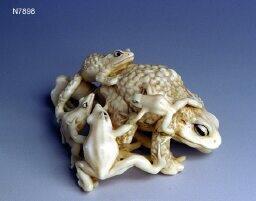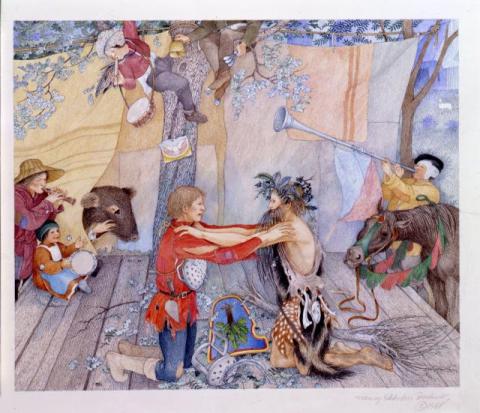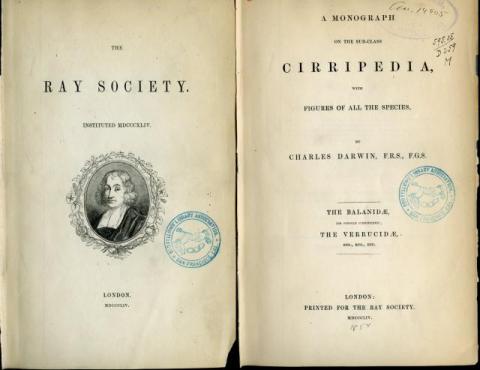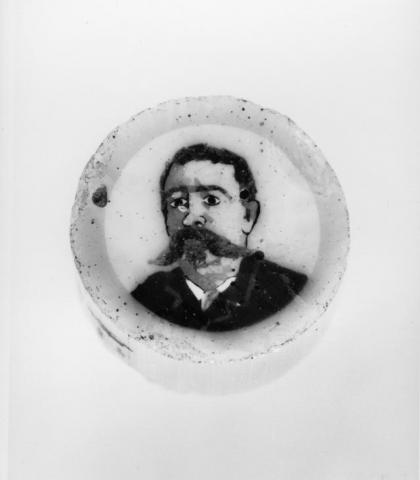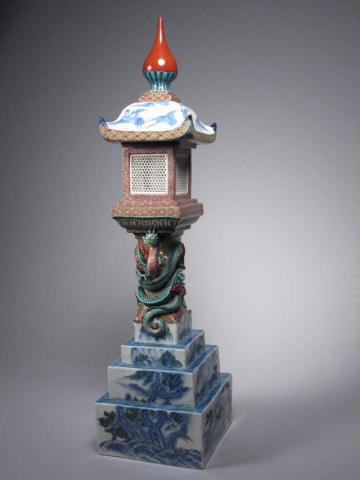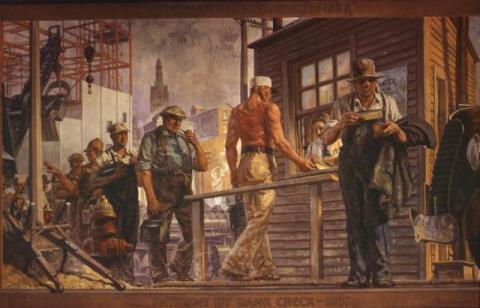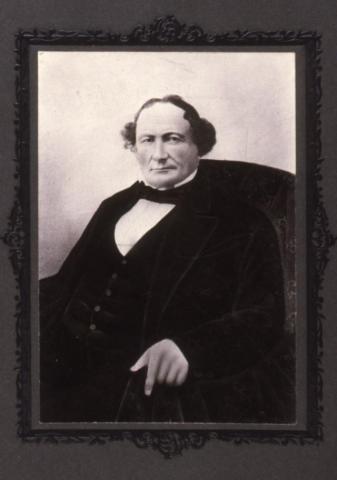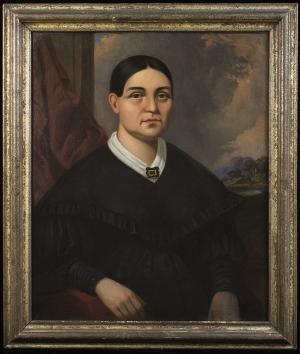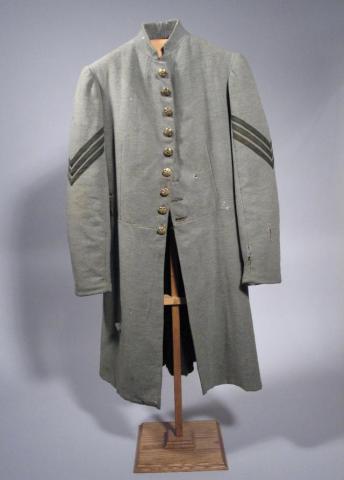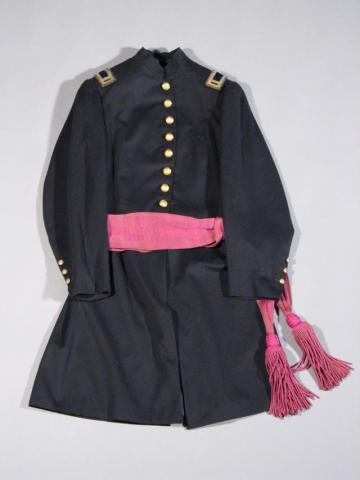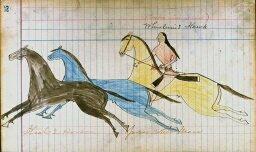MPM's curatorial and collections staff have selected more than 100 important, unique or interesting objects to highlight from the more than 4 million items in the Museum's care. These items reflect the depth and breadth of the collections.
Many of the items featured below are not on exhibit due to their fragile nature. One of the Museum's primary goals is to preserve objects for generations to come.
As a virtual exhibit, we can share with people around the world our most rare and intriguing items without harm to them.
Dating to 1895 and depicting "Venus instructing Cupid," the Northwood Cameo Plaque is unique. Although George Woodall is considered the greatest carver of English cameo glass, John Northwood was one of the first to carve this type of glass and is known to have made only seven works on cameo glass. He sparked a period of Greco-Roman recreations on glass and revitalized British interest in Greco-Roman glass works.
In 1903, Harley-Davidson began its motorcycle business in Milwaukee, Wisconsin. This item, a 1913 Harley-Davidson motorcycle, was manufactured during a time of great production and growth for the company. That year, Harley-Davidson built a new, much larger factory. The following year, production numbers soared to 16,284 motorcycles. After 1914, Harley-Davidson dominated the motorcycle industry. This machine serves as a marker of this time of economic and industrial growth for the Harley-Davidson motorcycle industry. It is currently on display in the Streets of Old Milwaukee exhibit.
Unique to firearms history, this flint-lock Patrick Ferguson breech loading rifle is one of only 100 martial Ferguson's rifles made and dates to 1776-1778. Prior to breech loading weaponry, muzzle-loading firearms were used. The breech loading rifle revolutionized firearm warfare with a design that enabled faster reloading during battle. Breech loading rifles had been used for more than 200 years prior to Patrick Ferguson's design, but Ferguson's version of this breech loading flintlock weapon, made possible by improvements in more precise engineering, was a more successful weapon. The Ferguson rifle provided for faster reloading time and a lesser threat of exposure to enemy fire. Had the British adopted this technology during the Revolutionary War, the consequences for the Americans could have been devastating.
The Schloemer automobile, on exhibit in Streets of Old Milwaukee, was the first internal combustion vehicle to run on the streets of Milwaukee. This vehicle is a product of Gottfried Schloemer's and Frank Toepfer's interest in producing a self-propelled vehicle. After their first attempt, a bicycle-like vehicle that required its passengers to pull a bar back and forth to operate the crank shaft, Schloemer and Toepfer looked to other innovations. Schloemer and Toepfer borrowed the gasoline engine design from the Sintz Machinery Company in Grand Rapids, Michigan. The engine was a single-cylinder and ignition was provided by two steel points which made contact within the engine. The engine was placed below the seat and was powered by a belt system. Improvements in steering were made in time and other features were added, such as brakes. The vehicle was ultimately commercially unsuccessful but inspired others to improve on the design. The car was bought by the Museum in 1920 from Gottfried Schloemer, who used it to promote his business. This is the only one of its kind in existence.
In 1836, a patent was created for a weapon that used a revolving cylinder coupled with a stationary barrel. This was the first design for a marketable repeating shot firearm. Samuel Colt is attributed with the design of the first firearm under the patent" the Colt Paterson Pistol." A loading lever was eventually added to the design, enabling the weapon to be loaded without disassembly.
This rare carved ivory elephant was decorated with 428 precious stones set in gold trappings and dates to the late 18th century. It originated in India and is believed to be a gift to a raja. The piece was donated to the Museum in 1964 from a couple in Chicago who found it a beautiful piece of art. It is currently on exhibit in the Museum's India area.
In the history of American cabinetmaking, highboys are particularly valuable and important because they show advanced craftsmanship and artistry. This Connecticut highboy, dating back to the 18th century, is cherry wood with a double block front with bonnet top. The top has spiral (flame) finials and the highboy is supported by ball and claw feet. This particular highboy was once owned by a governor of Connecticut.
These ivory miniatures are the work of Jacques Louis David, a French neoclassic painter. The Josephine miniature contains an ivory oval signed by David in 1816, the year after Napoleon's last defeat at Waterloo. The Napoleon miniature is set in a brass frame that is decorated with fleur de lis and scrolls. These items are a contribution of I.A. Dinerstein, a Milwaukee lawyer and avid collector of art and decorative art.
This decoy, obtained in 1967, was carved and painted to resemble a Canada Goose in a feeding position. Decoys are designed to attract birds from the sky and are often the products of expert craftsmen who are able to carve realistic ducks and geese from wood. This goose decoy is the work of Nathan Cobb Jr., a well-known artist in decoy carving from Virginia.
This toy train, modeled after an engine car, is equipped with a key wind top and four wheels. The removable top is painted gray with black trim. The Marklin Company, founded in Germany in 1859, once specialized in dollhouse design, but is now recognized for its toy train craftsmanship. In the late 1800s when Marklin began producing trains, the company created international standards for different gauges and scales for model trains that are still used today. In 1891, Marklin produced the first system railroad toy; this consisted of wind-up trains capable of towing cars, and a new and unique track system. Marklin trains began to be powered by electricity in the 1920s. This train, however, is unique because it still operates by a key wind.
This lamp from "Tiffany Studios New York" dates back to the early 1900s. The four-light lamp contains a glass shade decorated with a grapevine pattern and an antiqued wisteria bronze base. Tiffany lamps were first created in the late 1800s from the design of Louis Comfort Tiffany. Tiffany originally created stained glass for windows and then transitioned to staining glass for lamps. Tiffany glass lamps are traditionally made by hand, not mass produced by machinery, making them an exceptional and unique piece of glass art.
Known for their precise detail and distinguishing color, the Blaschka glass models are accurate representations of biological specimens. Leopold Blaschka and his son Rudolph were Bohemian, or Czech , by birth, but worked in Germany. MPM purchased 70 invertebrate glass models, which were offered for sale through Ward's Natural Science Establishment, Inc.
The models are known for their representative accuracy and have been accredited by the scientific community for their representative quality. Used as biological models, the glass works have been great contributions to the scientific community in providing scientists with models to teach and educate plant and marine anatomy.
One of the most famous Blaschka collections, the Ware Collection of Glass Models of Plants, contains almost 4,000 plants and flowers and is held at the Harvard Museum of Natural History at Harvard University. The Blaschka work also extended to marine invertebrates like the one shown here. Most of this collection is housed at the Corning Museum of Glass in Corning, New York. Leopold Blaschka died in 1895 and his son in 1939, but their work lives on and continues to awe and inspire artists, biologists, and lay people alike.
This horse is made of pinkish buff clay and with a painted white slip. Its "cold pigment" colors include rust, orange, pinkish, and traces of black. The horse dates to the T'ang dynasty in China, which lasted from 618-907 A.D. The horse was extensively restored before it came to the Museum.
It wasn't long ago that clocks decorated the streets of Milwaukee. As the city grew, buildings became modernized and development continued; the street clocks were greatly reduced in number. Most clocks were removed, as they were an obstruction to urban development. Milwaukee mayor Sherman M. Becker, known as the "Boy Mayor," found the clocks to be particularly bothersome and took matters into his own hands by ordering their destruction. One morning in 1907, he and a team of firemen destroyed most of the city street clocks. In 1976, Milwaukee had only one remaining, located on the corner of South 16th and Washington Streets outside of Jensen Jewelry. Upon his retirement in 1972, Jensen donated the clock to the Museum. Thomas J. Bliffert, president of Granville Lumber and Fuel Company, donated the funds for the clock to be restored. After hard work by the Museum staff, the clock now stands outside the Museum entrance on Wells Street.
Netsuke are artistic toggles that originated in Japan in the 17th century. These little figures of people and animals became a Japanese import to the states as early as the 1860s. They were made of many different materials such as ivory, wood, iron, or gold. Easily imported because of their small size, this factor contributed to their status as a very collectible object in America. In Japan, people used them to hang on the ends of their medicine boxes or on their kimonos. The Milwaukee Public Museum's extensive carved ivory collection includes over 300 netsuke, many of them on display in the Asian exhibit.
The Museum holds the sketches, notes, and original artwork that was published in Nancy Burkert's book Valentine and Orson, the story of twin boys separated at birth; one was raised by royalty and the other by bears. The artwork in this book was inspired by Brueghel in its artistic style, and Burkert was praised for her stunning artwork. Burkert was a long time UW-Milwaukee art professor, and before working on this book, Burkert illustrated Roald Dahl books such as James and the Giant Peach.
This first edition Darwin book, published in 1854, was originally cataloged in the San Francisco Library collection. By good fortune, the book was checked out during the 1906 fire that destroyed the building and made its way to the Milwaukee Public Museum's library a few years later.
The publication of this work not only established Darwin's reputation as a biologist, but as a result of the research, he discovered that barnacles represent a transitional stage between hermaphroditism (individuals with both male and female sex organs) and sexual reproduction. This strengthened an important insight of Darwin's – that sexual reproduction was essential for variation in species – and in natural selection, his central mechanism for evolution.
The glass cane mini-portraits are Italian-made. Glass cane is a way of stretching glass, making beautiful, colorful, and delicate artwork. The portraits are tiny round pieces of glass with a face of a person in the center. The glass cane portraits in the Milwaukee Public Museum are an example of true artistry and craftsmanship.
In 1886, a 14 year-old Rudolph Nunnemacher became involved with the new Milwaukee Public Museum when he donated his rock collection. His passion to collect continued through the years, primarily obtaining decorative arts items, guns, and East Asian religious imagery. When he died prematurely in 1900, nearly 2,000 items were willed to the Milwaukee Public Museum, including his housewares and paintings from all over the world. The Nunnemacher Decorative Arts collection has continued to grow through donations to the Nunnemacher Collection.
Susan Frackelton, born in Milwaukee in 1848, was a local artist for most of her life, but was internationally known and honored. She was a major supporter of the Arts and Crafts movement in Wisconsin and taught local women how to paint their own pots as a hobby. Frackelton's main type of artistic expression was pottery and she later started to experiment with salt-glazed stoneware. Frackelton was honored for the first time for her ceramic expertise at the 1889 Paris Exposition and in 1893, she won many awards for her stone glazed stoneware at the World's Columbian Exposition in Chicago. She also organized a large exhibit at the Milwaukee Public Museum in 1900 that incorporated decorative arts and discussions on women's issues. She was an inventor and developed a gas kiln. She also developed and marketed her own brand of ceramic paints and brushes. Later in life, she devoted her full attention to lecturing on women's issues. She died in Chicago in 1932.
One of President Franklin Delano Roosevelt's New Deal administration policies, the Works Progress Administration, offered jobs to keep people employed during the Great Depression. At the Milwaukee Public Museum, Director Samuel A. Barrett wanted to keep his staff employed, so he designated space for murals throughout the Museum to depict different exhibits and periods in world history. This endeavor allowed the current Museum staff to stay employed during a time when many people were losing their jobs. This mural shown here is by Albert O. Tieman and is titled Milwaukee Workers Being Paid by Check in 1937.
A French Canadian fur trader, politician, and land speculator, Solomon Juneau was one of the founders of the city of Milwaukee. In 1818, Juneau came to Milwaukee to work as a clerk at the American Fur Company's trading post in Milwaukee and saw potential in the city. Shortly thereafter, he won a preemption from the government and acquired land between the Milwaukee River and Lake Michigan. Here, Juneau developed the Milwaukee Journal and became the postmaster for the emerging city. In 1846, he was elected the first mayor of Milwaukee. The Juneau collection at the Milwaukee Public Museum includes many of his personal papers, including his business as a fur trader and his land dealings. The collection also contains portraits of Juneau and his wife, Josette, and some of his guns and surveying instruments.
Catalog Number
E19917
Accession Number
6610
Park City was the original name of Kenosha, Wisconsin and the Park City Grays were the local militia. The group was mustered into the Wisconsin 1st infantry at Milwaukee and sent, wearing their gray coats, to guard Washington, D.C. at the outbreak of the Civil War. Before the Civil War, the color of the 1st Wisconsin Militia (as well as many other states) was gray. However, gray was the color of the Confederate Army as well, and at the beginning of the Civil War, the Union quickly changed their color to blue. This coat was worn by Sergeant Warren Graham in 1861. Graham, a Milwaukee native, was the first casualty of the Civil War to be buried in Wisconsin.
This Mitchell Civil War uniform, part of a larger group of Mitchell militia material, belonged to John Lendrum Mitchell, son of prominent Milwaukee banker Alexander Mitchell. John served in the Wisconsin 24th Infantry and rose to the rank of 1st Lieutenant. After the Civil War, John was a gentleman farmer and had a large estate in what is today West Allis, Wisconsin. He was very well educated and served in the Wisconsin legislature and later served as a United States Senator. John's second son, William, rose to prominence in the U.S. Army Flying Corps in WWI and was a strong proponent of American air power and founder of the modern Air Force. Mitchell International Airport is named for him. The Mitchell family is recognized as one of Milwaukee's first families.
This ledger book was "captured" by Captain R. Miller from Red Hawk on January 8, 1891 at Wounded Knee Creek, South Dakota, shortly after the Wounded Knee Massacre. The Milwaukee Public Museum purchased the ledger from collector H.H. Hayssen in 1897. Ledger art was a medium of Plains Indian art from the late 19th to early 20th centuries and illustrates the changes in Plains Indian life during this time. The Red Hawk ledger consists of 105 ink and crayon drawings done by Red Hawk and other Sioux men. Learn more about this collection here.


